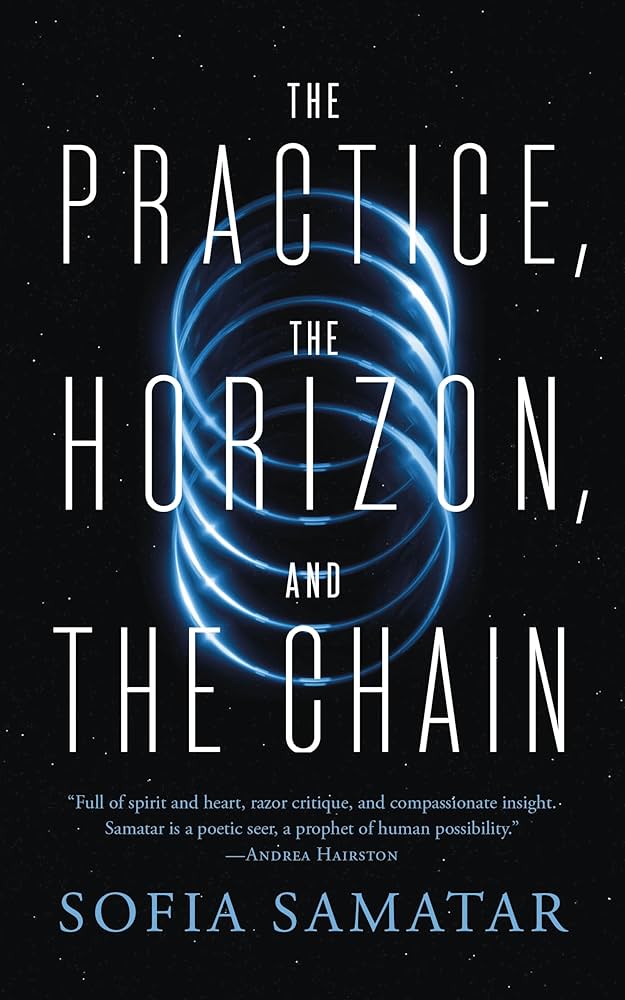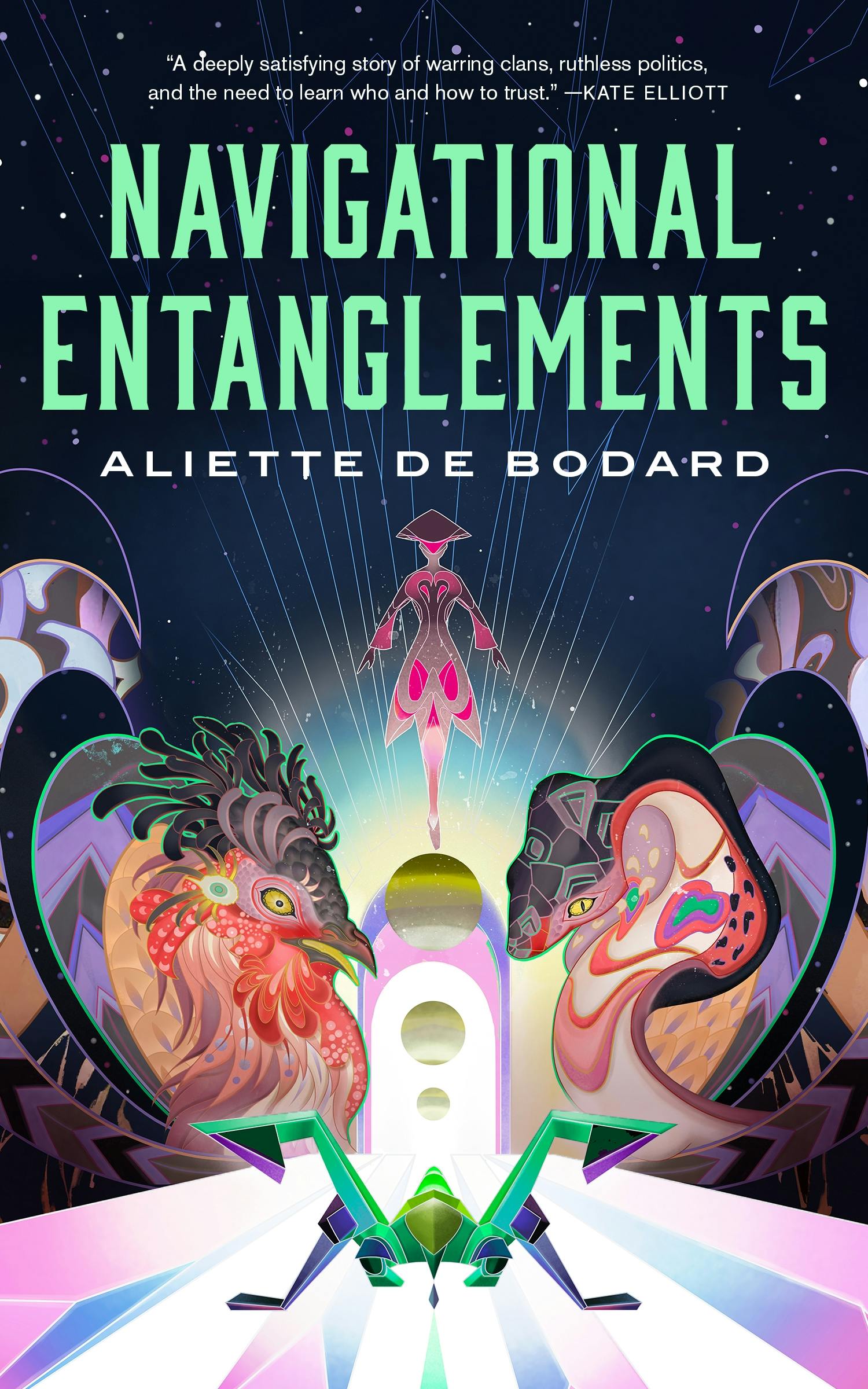It’s a bit of a space-travel review this week as I read two more Hugo-nominated novellas: Sofia Samatar’s story set in a caste-system aboard a generation ship, and Aliette de Bodard’s planetary-hopping monster hunt.
The Practice, The Horizon, and The Chain – Sofia Samatar
He spoke of the Wilderness and the River of Life. He spoke of the Wheel in the Middle of the Air and the Valley where the Bones lay sleeping. He spoke of the Star called Wormwood that makes the waters bitter, and afterward the boy put these things into some of his pictures.
Sofia Samatar’s entry works on multiple levels. It’s a slice-of-life space opera set on one of several Generation Ships that abandoned a destroyed Earth years ago. It’s a poetical exploration of the entire concept of connection. And it’s a bitingly hard, satirical look at how societies divide themselves, not based on skill or education, but on the need to invent a lower class so the upper classes have someone to feel superior to. In so many instances, the cruelty is entirely the point.

We start from the viewpoint of the boy (Not everyone has a name, because not everyone is considered people.) The boy was born and raised in the Hold, a level of society that spends their entire life in the windowless bottom of The Ship, and who’s entire culture – traditions, games, relationships – is based on the fact that everyone is surgically attached to their chains. Someone notices that the boy has an aptitude for art, so as part of some sort of cultural outreach (read: let’s show off how much empathy we have for the less fortunate) he’s brought upstairs to the part of the ship with things like clean air, and parks, and windows. His chains are replaced with a glowing blue anklet, and he’s assigned to learn, and to display for everyone what a wonderful opportunity he’s been given to improve himself.
The reader is instantly immersed in the world of The Ship, and a lot of that is because we’re dropped into the boy’s world of The Hold with very little explanation until the details gradually expand around us like a ripple in water. As hard a life as it is in the cold, windowless, privacy-less prison, this is the boy’s home. This is his life. Being dragged out of his cell, separated from his chain, de-loused and dressed and given a room with actual furniture is nightmarishly disorientating to both him and the reader. The boy also has his own way of seeing the world and all its chain-like connections. The result is a dream-like quality to his chapters, observations rising up to the surface like poetry, homesickness and curiosity and fear all competing with each other as he learns not just about his new home, but what exactly is expected of him…
…which in a lot of cases is smiling and nodding while his teachers and patrons condescendingly explain his own experiences to him, as if they’re much more qualified to know things about his life than he is.
She liked him to agree with her, to laugh, and to shake his head incredulously, as if astonished by how much she knew about him…
The other chapters are told from the viewpoint the of boy’s main patron. The woman is the daughter of a man who was raised up from The Hold in the same program that found the boy. She also has a glowing blue anklet, and the same politely-never-commented-upon status. The author takes a moment to poke at some of the more ridiculous elements of academia: the jockeying for power, desperate for recognition, performing outreach without really thinking about the people they’re reaching out to, the eternal focus on meaningless details. (One of the woman’s proudest moments is an award she received for successfully lobbying to change the name of her department from Old Knowledge to Older Knowledge. Because calling something “old” is dismissive, and that’s important.)
The woman finds herself drawn into the boy’s Practice, his ability to breathe in the connections, to find his purpose and to reach back down to the Hold family. She’s still resisting though, trying to hang on to her position with her fingernails, to prove to her colleagues that she’s good enough, valuable enough, obedient enough to stay, and maybe to make things a little better. (Did you know that some of her colleagues get to take the upper-class ferries to other ships? And have cocktails?) The reader can tell from her almost crawling desperation that her doom is just around the corner, that her comfortable situation is secure right up until the second someone above her is inconvenienced. The moment when it happens is still shocking, a trainwreck you can’t look away from. It’s almost as surprising as the moment when the trainwreck stops.
This is more than just the middle class being deluded enough to think they’re any safer than the people below them. What becomes crystal clear in this story is that literally no one is safe. Work hard your entire life, do everything right, and you can still lose it all as soon as everyone decides there’s an acceptable number of lives you can destroy to make things comfortable for everyone else.
It’s hard to not read today’s political climate into this story. The way the boy begins to fight back, using the Practice and his way of seeing the connections in everything is a little like a fairy tale. But it also feels like a rallying cry. In a society divided into levels, any power that’s taken away from the people at the bottom can taken away from everyone.
Navigational Enganglements – Aliette de Bodard
Việt Nhi had resigned herself, early on, to not liking people…
I have to be careful when describing Aliette de Bodard’s novella, since it’s something of monster hunt in space, bookended by complicated political intrigue and a murder mystery that I really don’t want to spoil.

There are an infinite number of ways that authors create to get around the whole you-can’t-travel-faster-than-the-speed-of-light problem with interplanetary travel. Bodard’s method for this particular slice of the universe is the Hollows, an in-between place that navigators can access by opening a portal and covering the ship in their Shadow. The Shadow is…something that I had a little trouble understanding when I started the story; for a while I thought maybe I’d skipped a book that explained things. As near as I can tell, Shadows are life-energies summoned by navigators from their own bodies. The Shadow is a shield, but also a weapon, and in moments of stress it will loom over the navigator like a demon, but some of the characters use it like a comfort blanket. There are several clans with navigator powers: Rat, Ox, Snake, Rooster (and Dog, but they prefer to be imperial enforcers instead of navigators). Each clan has a different form of Shadow, and each navigator has their own preferred styles of combat and protection.
Did you get all that? Well the technology may be complicated, but the problem in the story couldn’t be simpler, at least at first. The Hollows are the fastest way to travel between the stars, but there are also monsters waiting inside. And now one of them has gotten out.
A skillful navigator would use their Shadow to fend off tanglers, both during the navigation in the Hollows and during the opening and closing of navigation gates.
Clearly, something had gone wrong.
Tanglers are horrifying spectral monsters that only navigators can see. It’s too simplistic to say they feed on brains, what they do is feed on basic brain functions. Anyone touched by a tangler tentacle eventually dies when they lose the ability to do things like move, or breathe. As you can imagine, having one loose in the universe is a great big deal, so the clans have each sent a representative to form a hunting group to capture and/or kill the monster. The task requires the best of the best. So it’s weird that they pick four junior clan members who all have their own traumatic history, social weaknesses, and reasons to dislike, hate, or actively want to murder each other, most especially the irritating representative from Dog clan, who doesn’t seem to like anyone and for some godforsaken reason is also their leader.
Then the leader turns up dead, with no suspects, and now nobody knows who to trust. And somehow this all feels like it was part of somebody’s plan.
“…I don’t think we were meant to succeed.”
The scenes of traveling through space via glider-like creations, or either doing battle with hulking tentacled monsters or hand-to-hand combat using only their Shadows are all intriguing, but the real draw of this story are the wonderfully flawed characters. Việt Nhi is the narrator for half of the chapters. Nhi is a skilled navigator and a brilliant investigator, able to intuitively pinpoint cause and effect with science and sociology. She also doesn’t like being touched, gets overwhelmed by too much noise or company, and knows that no matter how careful she is, she’s eventually going to drive people away with her bad habit of knowing things, and then saying those things out loud.
Most people didn’t appreciate being told all of the truth, and Nhi couldn’t always understand where the tipping point was between being honest and scaring off people.
I imagine a lot of people will see something of themselves in Nhi’s loneliness and her constant struggle to figure out the ever-changing rules of human interaction, something which everybody else seems to just know. But the other members of the team have their own fascinating flaws as well, especially Hạc Cúc, the navigator from the Snake clan. Skilled assassin, terrified of her own temper, utterly convinced that she’s never going to be worthy of her sainted instructor, Hạc Cúc is at the center of most of the conflicts in the group. I lost count of the number of times an offhand comment resulted in a standoff between two or more people shouting what basically amounts to “You take that back!” Hạc Cúc is very good at finding people’s weakest points – almost as good as Nhi is – and both of them have learned that every relationship is going to end with the other party seeing what they’re capable of and walking away. A love affair for each of them is a bad idea. So of course the two of them are irresistibly drawn to each other. Not that they’re willing to admit that, of course.
Bodard balances tension with humor in the interactions between the team members. Hạc Cúc will jump from sarcasm to rage in a way that’s always entertaining to watch, while Nhi has a dry way of delivering cutting truths that can either defuse a conflict or tick someone off to the point where they temporarily forget about trying to kill someone for using the wrong honorific. For all the infighting, the story morphs to a found-family, us-against-the-universe dynamic remarkably quickly. The author also spices up the usual will they/won’t they dance between Hạc Cúc and Nhi with some tasty hurt/comfort scenes, which is always catnip for me.